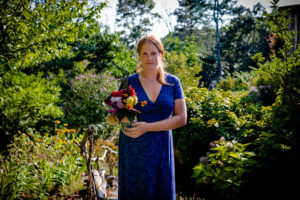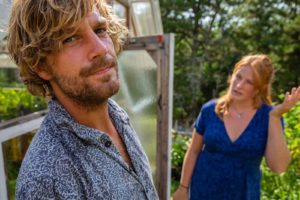TRURO — At least 11 Truro farms are providing local markets with fresh produce and flowers this year, up from just one farm in 1987. But it may come as a surprise that half the growers at the Truro farmers’ market cultivate land they do not own. Instead, these farmers have leases or more informal arrangements with landlords to farm their land.

Jessica Taylor of Here & There Farm says that, without this kind of tenant farming set-up, her business would not exist.
“I don’t think we would ever conceive of farming on Cape Cod if one of the expenses had to be buying land,” she says. Taylor started farming for market this year with her partner, Blake Olson.
With high property values and little available land, it’s no wonder that farmers are looking for alternatives to buying land on the Outer Cape. In Truro, 70 percent of the land is in the Cape Cod National Seashore (where new commercial enterprises are prohibited), and developable land goes for $120,000 to more than $400,000 per acre, according to a current online search for land for sale. For young would-be farmers, the cost is simply out of reach.
Farm tenancy has enabled new farmers to try out agriculture without the huge startup costs of purchasing land. Studies show that farmers who start with high debt are less likely to succeed in the long term. So the future of farming on the Outer Cape may depend on increasing the number of these agreements between growers and land owners.
Helping the environment and the local economy
Sustainable CAPE founding director Francie Randolph says that tenancy is good for farmers and land owners. Farming helps regenerate soil, maintain biodiversity, support pollinators, and sequester carbon in the soil, which can help mitigate global warming caused by greenhouse gas emissions. Land owners, by leasing their land, bolster the local economy by providing farmers with the most basic necessity for employment.
“Once the desire is there,” says Randolph, “and the knowledge that we can have a robust local food system here, people who own land might say, ‘Gee, I have this extra land. Wouldn’t it be great if we could get a gardener to farm out here?’ ”
Owners who rent their land are not typically motivated by profit. “It’s a philanthropic relationship,” Randolph says. “A lot of these situations are just people acting out of the goodness of their hearts.”
Ron Singer of Depot Road has an informal agreement with farmers Bhala and Digree Rai, who operate Down Home Farm. The couple has been farming one acre of Singer’s 3.5-acre lot for the past four years.
Singer doesn’t see much downside to letting the Rais farm his land. “There’s less grass I have to cut,” he says. The Rais’ farm plot was previously a big lawn. They also offer him a portion of their harvest. “Every day they ask if I want greens to make a salad, so I have fresh produce every night,” Singer says.
Though there are benefits, farming other people’s land is not always straightforward.
Many farmers work multiple parcels. Taylor and Olson are currently farming three different plots scattered around Truro that total less than a half acre. The largest plot is at their apartment.

For Taylor, traveling between three plots is a time sink. If they farmed only one, “it would be a million times easier,” she says.
To limit travel and work time, Taylor plants crops close together to shade out weeds and uses automated irrigation systems. Delicate crops like flowers, which she needs to monitor more closely, are grown on the plot at her apartment.
Agreements can be formal or informal
Taylor and Olson don’t have leases for their rented plots. “It’s all verbal commitments,” says Taylor. “Nothing has gotten serious yet.”
She views this first season as an experiment. She says she may want to take on more land in the future, but for now her three small patches are sufficient to explore her interest in farming and how to work efficiently in limited space.
Such informal commitments are risky. The land owner can decide at any time to terminate the agreement. Farmers, too, might back out suddenly, leaving land owners with equipment and altered landscapes to clean up.
More established farmers maintain formal commitments with owners to mitigate these risks.
Dave DeWitt of Dave’s Greens has been farming for 32 years, always on land he does not own. “All the farming I’ve ever done has been on rented land,” he says. DeWitt currently rents from three property owners in Truro.
DeWitt says he has learned that leases must clearly define the working relationship between him and land owners, including profits. On two of his plots, “I work on percentage of sales of the crop that comes off the field,” he says. “That way, I minimize some of the risk from weather. If a hurricane comes and destroys my crops, I’m not paying full rent on a bad year.”
DeWitt insists on long-term leases — renewable every five years. He says a one-year lease would be too risky, because farmers need multiple seasons to understand the quirks of topography and soil conditions unique to their land.
Especially with the notoriously sandy and acidic soil of the Outer Cape, farmers invest heavily in increasing its fertility, which can take years.
The “lasagna method” involves layering compost and manure over the winter to make the soil more hospitable to vegetables, flowers, and fruits. Some grow cover crops, like clover, which they plant in the fall and then till into the ground in spring to restore nitrogen in the soil.
“Farming is a long-term plan,” Randolph says. “You don’t want to build the soil for five years and then find the lease won’t work out.”
The percentage of his profit DeWitt pays to landlords is based on soil conditions. In the initial years of working a plot it can be small. “Instead of just giving 10 percent off the bat,” he says, “I start at one percent and work up to 10 percent as the soil gets more productive.”
Taylor turned down potential plots because they would require too much investment. “In a couple places, we would have had to cut down trees or put in soil,” she says. “We didn’t go with those spots for that reason — it’s a lot of investment and labor if something goes wrong. Dirt is expensive.”
Tenant farmers must also compromise with landlords. Compared with having freedom on their own land, this can be tiresome.
“I am a guest,” says Taylor. “I want to be polite and give people privacy. It would be a lot easier if I could do anything whenever, wherever.” Although she often wishes to linger with her seedlings, Taylor tears herself away out of concern for the land owners.
DeWitt has also learned to compromise. “If you’re having company over for dinner, just let us know and we won’t turn on the tractor,” he says. “We won’t run irrigation when it’s prime shower time on your property. Open communication can help avoid conflict.”
Matchmaking is not easy
Both DeWitt and Taylor think the farming community would benefit from more awareness of the tenancy trend among land owners. It’s often difficult for farmers to find land or land owners to find farmers. They say a service that links farmers with owners would help.
The New England Farm Finder is an online database that allows land owners to post properties they hope to lease or sell to farmers. But there are many more farmers looking for land than properties posted, and of the 30 properties currently listed in Massachusetts, only one is on the Cape, in Barnstable.
Besides, locating farmland is only the first step in making a match.
Land for Good, a New England-based charity founded in 2002 that works to secure land for farming, provides educational resources and advice for farmers and land owners on land access, tenure, and transfer.
Kathryn Ruhf, senior advisor at Land for Good, says there are many different ways farmers and landlords can negotiate ownership, and that not all matches are successful.
Although Massachusetts offers a tax break for agricultural land under Chapter 61a, to qualify a farm must be at least five acres and earn $500 in profits annually. Towns do not typically negotiate leases or provide matchmaking services. Instead, nonprofit organizations or charities act as intermediaries between tenant farmers and landlords.
Farm tenancy is not well known but is extremely common. Ninety percent of farmland owners nationwide do not farm their land.
“For many farmers, owning their own farm, including the farmhouse, is a dream that they want to strive towards,” says Ruhf. “For others, they don’t need to own the land at all. The conception that you’re not a real farmer if you don’t own your own land is a myth.”
This sentiment rings true for Dave DeWitt. “It would be way easier to own the land,” he says. “But if you don’t own the land, this is a very good alternative.”
Although he could afford to buy land in western Massachusetts, DeWitt chooses to stay on the Cape. “I could have 100 acres of real soil in western Mass with the money I make on Cape Cod,” he says. “I choose to live on the Outer Cape. It’s a quality of life over quantity of money situation.”
Taylor says Here & There is not yet turning a profit, but she and Olson are breaking even this season and are excited about what’s next. She feels that farming other people’s land also helps connect people to their food.
“It’s good to know where your food comes from — to understand what it takes to grow something,” Taylor says. “How much time and labor and effort it takes to get things growing right.”



